
Wednesday, September 30, 2009
SHOOTING THE HERON

Tuesday, September 29, 2009
AMBLING INTO AUTUMN
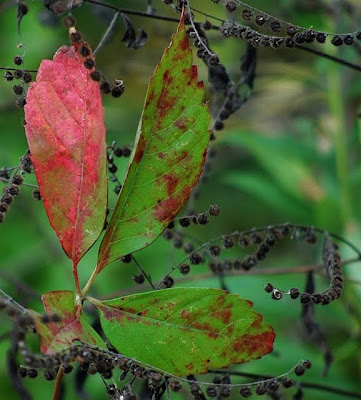



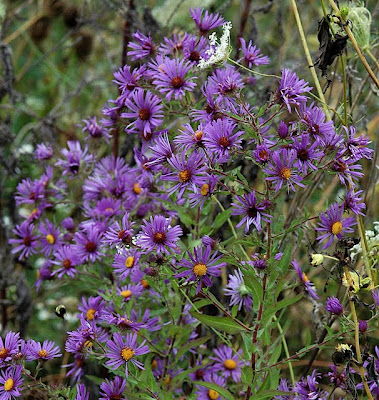

Sunday, September 27, 2009
A BIT OF SEASONAL COLOR

Thursday, September 24, 2009
AUTUMN LIGHTS

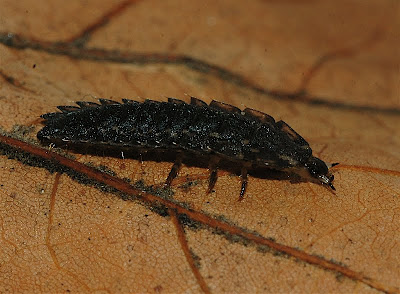
Wednesday, September 23, 2009
AUTUMN'S FIRST FULL DAY

Tuesday, September 22, 2009
EQUINOX & LEAVES

We have reached another equinox—the instant at which the center of the sun crosses declination, or the celestial equator. Though it was not always the case, we moderns now employ equinoxes (along with solstices) as our dividing lines between seasons. That means summer is over today…or will be at 5:19 p.m. EDT hereabouts, which—according to the almanac—is also the moment when autumn officially begins.
You often hear folks say an equinox is when days and nights are of equal length. Twelve hours of daylight, twelve hours of darkness. Sorry to disappoint, but this is just not the case. You’ll have to wait several more days for that balance to occur.
In spite of what you’ve likely been told, day and night are never the same length on an equinox anymore. There are several reasons for this imbalance. While the refraction of sunlight as it passes through the earth’s atmosphere has some effect, the main culprit which created the rift stems from the way sunrises and sunsets are currently pinpointed—along with the way we calculate an equinox.
The one-time fact is now just a quaint fantasy. The truth is, on an equinox, the days are always a bit longer than the nights. The original etymology of the word “equinox” is no longer valid.
Not that it matters in any meaningful way—seasons are just words we use to generalize our location along the great circular route of that annual journey we call a year.
Is today’s equinox day identical to last year’s or the one before that? Will next year’s equinox be the same?
Of course not. No two years, no two days, no two moments are ever exactly alike. Each and every second since time began has been unique…and therefore precious.
An hour ago I stood at the edge of the river and watched a handful of leaves being carried along on the slow current. A few weeks ago you rarely saw a leaf on the water, but each day now their number visibly increases. Three weeks hence the water’s surface will be carpeted by multicolored leaves from countless trees upstream.
There’s something satisfyingly eternal about seeing leaves float down a September stream. Observing their passage somehow welcomes me into time’s continuum.
I quite aware my own days on this earth are limited. Yet I can’t believe I’m the first man to stand on the banks of this lovely sycamore-lined stream and mark a new autumn by noting the leaves already slipping downstream. And I hope I’m not the last—that those who come after will treat this fine old river with love and respect…and will also find solace in greeting the season with a pause to watch leaves.
Friday, September 18, 2009
GETTING READY FOR THE CHANGE…
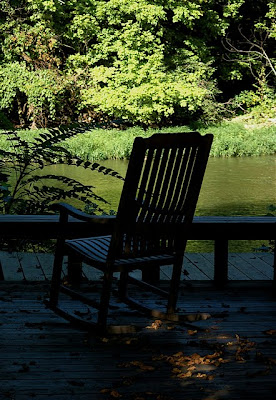
This morning served up one of those astonishing cusp-of-autumn treats you wish you could store in a bottle and pour out some dreary winter afternoon when you needed a bit of cheering up.
On the deck, I slid the rocking chair to the end overlooking the river, where I could sit with my feet up on the bench and savor a third cup of coffee while better taking in the view.
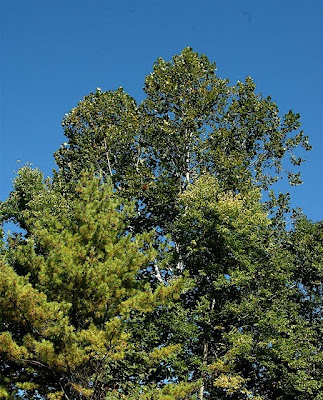
The sky was brilliant and clear, of a shade somewhere between azure and cobalt. A turkey vulture came floating above the tops of the trees and began spiraling upwards over the river—a wheeling silhouette amid the luminous sea of blue.
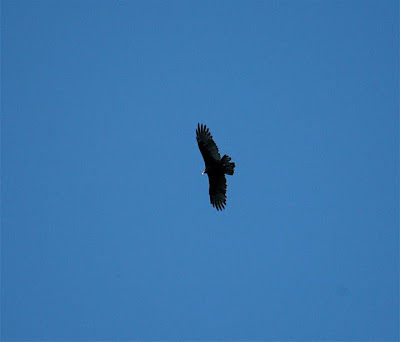
What I wouldn’t give to be able to ride the rising thermals high into the sky like that old buzzard…
The deck was in shadows, cool and still damp from the night’s dew. Moon, a most sensible dog, found herself a pool of sunshine on the gravel driveway in which to stretch out and warm her aging bones. My aging bones could have used their own bit of heat treating—especially since I spent most of yesterday afternoon planting bushes and perennials around the yard.
Hereabouts, digging even a modest hole often entails—besides the usual shovel—a heavy-duty crowbar, a pix-axe, mattock, hours of time, mulish patience, a willingness to sweat, a handy vocabulary of imprecations, a reckless disregard for blisters and personal bloodshed…plus the sense and willingness to admit defeat when nothing short of a stick of dynamite is going to get you another inch into the rock-filled earth.
You don’t so much dig as you chip and scrap and curse your way to victory.

Autumn color is not yet much in evidence here along the river—though the sycamores have a few gold-brown leaves scattered among the green, and the hackberries are showing a bit of pale yellow.
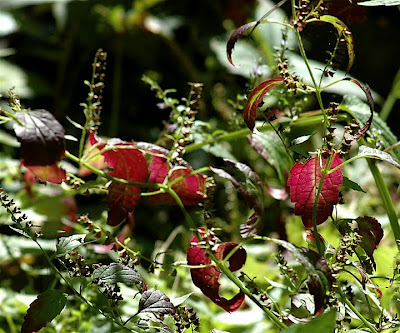





I hoped it wasn’t the big army-green grasshopper who kept eyeing me from atop a fallen leaf where he sat, lethargic in the coolness, waiting for the temperature to rise and get him charged and going.
You don't get many mornings such as this in a given year. Certainly not near enough. So I dawdled as long as I could, nursing my coffee, rocking, listening to the river…and thinking how much I love these transition days, when the seasons are on the move and the world around is responding, changing, getting ready.
Sunday, September 13, 2009
BAD FEATHER DAY
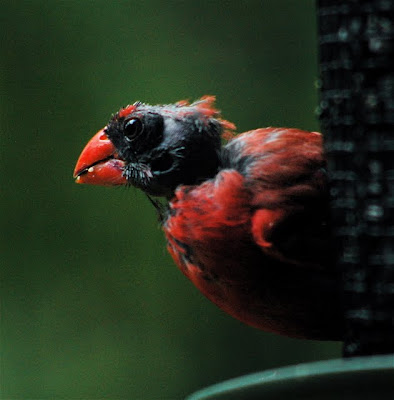
Beauty is only skin deep…or in some cases, feather deep. At least if you’re a male cardinal caught in the embarrassing throes of an unusual molt.
The goofy-looking redbird, which could almost have been mistaken for a scarlet-plumed pigmy vulture, appeared at the feeder outside my study window yesterday morning. The light was low, but I didn’t figure I had time to change settings on the camera or grab a tripod—so I snapped a quick shot and hoped for the best. The result isn’t the best of photos, but it’s certainly sufficient to reveal the usually handsome and cocky cardinal at his decidedly unflattering worst.
I actually felt rather bad about making his portrait. Like I’d become a member of the paparazzi who lurks outside the doors of fancy hotels or gated mansions in the Hollywood Hills, shooting pictures for the tabloids of movie stars when they’re overweight, without makeup—or in the case of more than a few men—lack the masculine mental-reenforcing enhancement of a toupee.
Had I joined the ornithological version of the gutter press?
This cardinal definitely got caught away from the thicket without his hairpiece…er-r-r, featherpiece. And since the single most defining feature of a cardinal—male or female—is their crest, I can see where such a loss might lead to temporary insecurity issues. The bird did seem extra jumpy, looking nervously around before snatching a sunflower seed; and maybe, too, a little angry, put upon, as if life had treated this poor old redbird unfairly.
Well, maybe he had a point.
According to June Osborn, in her book The CardniaI, published by the University of Texas press, such a complete loss of feathers over a single area is not the norm. Usually cardinals molt via a gradual process—a few feathers from here, others from there, leaving enough plumage for protection and the power of flight.
Of course a bald pate wasn’t going to prevent this fellow from flying…but such a thorough, single-area loss was not how the change to new feathers is typically made. For a proud bird, it had to be awkward if not humiliating. I had to sympathize.

The good part is that the loss will be temporary; give it another week or two and that red-coated fellow can strut his stuff in brand new attire.
Saturday, September 12, 2009
SIMPLE SATURDAY MORNING

Saturday morning along the river. On the hill above the cottage, the rising sun is climbing through my neighbor’s towering sycamore. The air is cool and damp, sweet.
Moon the dog and I amble up the drive to the road so I can look in the mailbox, because I can’t remember checking it last evening. Nope, nothing inside. Which still doesn’t tell me whether I retrieved whatever there was yesterday, or forgot and the box is empty simply because nothing was delivered.
Either way, I’m probably losing my mind.

The grass wears a silver sheen of dew. It is still a deep, luscious green. Here and there tiny water droplets sparkle like diamonds on velvet.
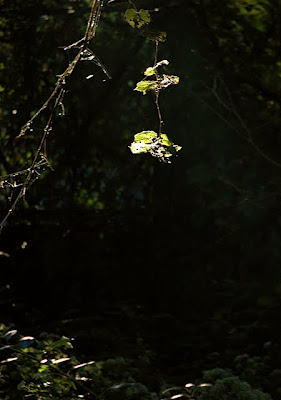
In a shadowy corner along the fenceline, a few tattered leaves hang suspended in a bit of sun, illuminated as if by a spotlight. Without the dramatic lighting those leaves wouldn’t merit a second glance. And yet now, momentarily, they’re quite captivating—made special by the light.
Isn’t that so often the case with us? Aren’t we all sometimes uplifted, transformed, made special by a certain setting and the power of an outside source? Love, for example—when it is good—brightens and inspires, raises us up, restores, empowers.
We can all always become so much more than the plain old mundane us when transfigured by an outside light.

Back at the cottage, I stand on the bank and watch the river’s moving mirrored surface scatter and swirl the pinkish morning sunlight. I never tire of seeing the interplay of light and current.

Seasonal change is afoot here along the river—though there’s not yet much to see other than a few clumps of yellow-brown leaves distributed here and there amongst the otherwise still-green foliage of the sycamores.
The tiny quick hummingbirds are still hanging around. I keep expecting them to vanish any day—and they will, eventually, when whatever embedded bit of ruby-throat wisdom stirs and whispers its annual message—informing them the time to head south has arrived.

Not, however, on this sunny, blue-sky Saturday morning. The only thing moving onward today is the river….
Thursday, September 10, 2009
TWILIGHT GIFT
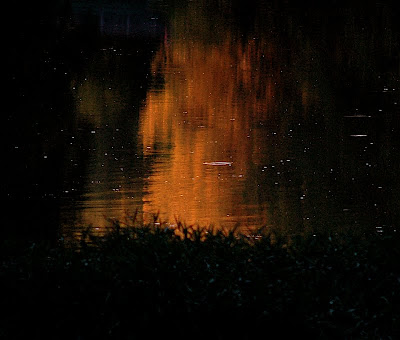
For me, this is a magical period, a time when it no longer seems prudent to believe only in those things which can be quantified and explained. Textbooks and peer-reviewed papers can never deal adequately with twilight.
At twilight, land and water and sky are charged with ancient mystery. Reality shifts. Secrets lurk in the darkening shadows. Things best accommodated by old knowledge—tales told round a fire by gray-bearded elders, stories passed via careful whispers in pine-fragrant glens.
Anything is possible…
A few nights ago I was sitting on the bench overlooking the river. The sunset had not been spectacular, merely a dwindling of the light in the west. Moments earlier, I had managed a photo of the vanquished sun’s final orange gleam as the fiery light bounced off the high crown of a big, white-barked sycamore upstream to be mirrored in the pool below. A sort of reflection-of-a-reflection shot.
Now the sky was the color of old pewter, barely distinguishable above the island’s treeline. The swallows were long gone and the earliest-feeding bats were already fluttering about. That’s when twilight favored me with a rare gift and I saw the nighthawks.
Migrating nighthawks are one of the quintessential last-of-summer sights in Ohio as they head for winter quarters in South America. Over-flights of birds typically begin passing through anywhere from the last week in August to the first few days of September. Late afternoon and twilight is their preferred travel time—or at least the time I generally spot them sailing along overhead.
The flight I observed the other evening was by far the largest I’ve ever witnessed. First there was a single nighthawk…then two. Then a handful, perhaps a dozen scattered loosely, then five or six, ten, four, a single…fifteen! Group after group they came, an unhurried, steady progression that might have revealed two or three dozen birds total at any one time.
A hundred nighthawks crossed overhead. Then two hundred. And still the birds kept appearing from the northwest, heading southeast. Twos, threes, a half-dozen. I was now straining to see them in the gathering darkness, missing many, losing track of others before I could make out their count.
How many were there? I honestly don’t know—but certainly several hundred. A thousand or more was equally possible.
Unlike a traveling skein of geese, the nighthawks were totally silent. And yet, long after it became too dark to see anything, I believe those migrating nighthawks were still passing above me—I seemed to feel their moving presence up there in the ebony sky.
Wishful thinking? Fantasy? Perhaps.
Tuesday, September 8, 2009
WAXWING TIME!

A few months after moving into this streamside cottage, I was sitting on the narrow deck which spans the width of the building and overlooks the big riffle and pool below. I’d already come to think of this end as the front of the house, and the river immediately beyond as the best part of my yard.
The midday sun was bright and warm, the high September sky a soft Dresden blue reminiscent of my grandmother’s eyes. Looking across the narrow channel to the trees on the island, it was plain to see that summer had run it course and autumn was already remaking the landscape. Here and there I noted the first brush strokes of lemon yellow on the sycamore leaves, and a singular scarlet flame in the twining Virginia creeper.
I felt uncommonly at ease. No lord of any stately manor ever stood upon a high terrace and viewed his sprawling estate below with greater pleasure. Not for the first time, I thought how love so often awakens in us the desire to live a long life. Whether it’s love of a person or a place, something stirs inside and we suddenly wish for endless time to enjoy, ample opportunity to savor that which fills our heart to overflowing with wonder and contentment.
Please, God, we beg…please, please, please lengthen our allotted span that we might know completely this generous blessing.
That’s how I felt upon moving here—and what I was thinking about that glorious day on the cusp of the seasonal change four years ago; cognizant, too, that time flows ever onward, like the water purling over rifflestones in my beloved river, aware that’s it only through grace that next year, next week, or even the next minute becomes ours to claim.

Perhaps it was these bittersweet musings that caused me a certain confusion when the first bird swooped quickly across the stream, dipping low over the pool, then rose, spun in midair, made a second pass back across the pool and returned to land in a hackberry leaning over the channel.
Hey—what was that bird? Not a swift, swallow, or martin. Flycatcher? Nahhh. And why did it look so familiar?
Another bird made a fast, twisting series of passes over the pool, was joined by a second, and then there were three or four zipping and diving like midday bats above the water. As they flew they revealed flashes of bright cadmium yellow on their tails, as if the tips had been dipped in paint. Sometimes I fancied I could spot a bit of red on the wings.
The feeding birds were taking pale, rather large mayflies which I could occasionally see coming off the water. I’ve watched other birds—mostly swifts and swallows—do this along trout streams all over the country.

Gezze…no wonder they looked familiar! I’ve seen cedar waxwings feeding all my life—except they’d usually been feeding on fruits or berries. Moreover, they were typically in the brushy borders adjacent to fields and meadows—noisily, cheerfully, eating whatever they could find.
I simply hadn’t expected to see them acting like flycatchers over a river. Then I remembered how I’d once watched a bunch of hungry cedar waxwings save a neighbor’s apple crop.
A plague of canker worms had begun devouring the leaves on the dozen old apple trees in his back yard. Suddenly one morning, like a phalanx of caped superheros in a comic book, a flock of cedar waxwings came flying in to the rescue.
Over the course of two or three days, the birds—perhaps thirty total—decimated the canker worm population. In short order it went from several worms on each and every limb to virtually zero. In fact, if even a single canker worm survived their onslaught, my neighbor and I couldn’t find it during an hour of searching afterwards.
Of course, most of the time cedar waxwings do eat various berries and fruits, including the glaucous blue berries of their namesake red cedar. Sometime to the point of apparent gluttony. Numerous sources report finding waxwings on the ground underneath a fruit or berry tree, having so overindulged they simply fell off the limb—helpless, unable to fly, stomachs and throats stuffed with berries…and still holding even more berries in their mouths and beaks, waiting for room to swallow!

What I’d observed was nothing new…just new to me.

